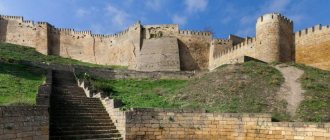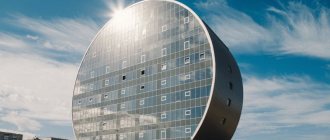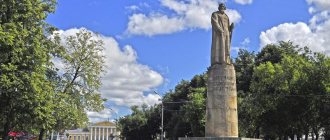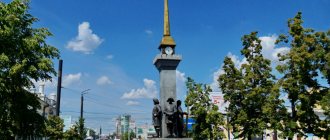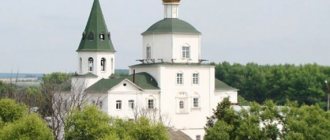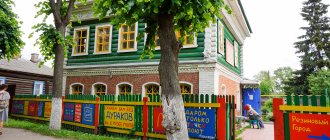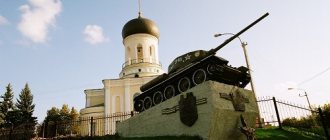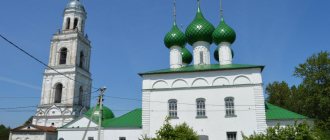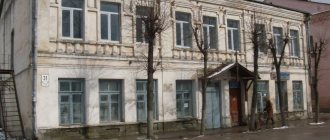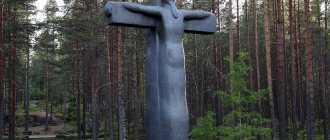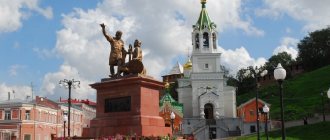Wedge
- a city of regional subordination in the Moscow region, the administrative center of the Klinsky district.
coat of arms
Population (2010) 80.6 thousand people. (1992 - 95.1 thousand, 1972 - 84 thousand, 1939 - 28 thousand, 1897 - 5.1 thousand). The city is located on the banks of the Sestra River, 65 km from the Moscow Ring Road along the Leningradskoe Highway (86 km). Railway station on the Moscow - St. Petersburg line. A narrow-gauge railway previously operated in the city and its environs, owned by. Within the city limits there is a military airfield Klin-5 ([1]), capable of receiving aircraft of almost all classes.
Locality: Klin city
- Name: Klin
- Status: city
- Number of inhabitants: 84,000
- Applies to: Urban settlement Klin
Geographical coordinates
- Latitude: 56.331621
- Longitude: 36.729151
- Klin (city) on the map
wedge
general information
Klin is an old Russian town in the Moscow region, preserving its history and traditions from the distant 14th century. It acquired its modern appearance in the second half of the last century, but it has many impressive historical and architectural monuments. The quiet provincial streets of the city have an atmosphere of charming antiquity, attracting numerous tourists. First of all, Klin is famous for its religious sites and interesting museums telling about the history of the region and famous personalities. The oldest monument is the Assumption Church of the 16th century - a rare example of Moscow ancient Russian architecture. In the central part of Klin there are Trading Rows, a monument of urban planning of federal significance, recognized as one of the best shopping buildings of the pre-revolutionary era. Nearby is the impressive Cathedral complex of the 17th – 19th centuries, which occupies a dominant position in the architectural appearance of the city. Modern Klin is a developed industrial and educational center that plays an important role in the development of the region’s economy. There are large food enterprises, educational institutions, shopping malls, shops, hotels, clubs, cafes and restaurants here.
Story
The first mention dates back to 1317 - the Nikon Chronicle says: “... In the summer of 6825... Prince Yuri Danilovich of Moscow with Kavgady and with many Tatars and with the princes of Suzdal... went from Kostroma to Rostov, and from Rostov went to Pereyaslavl, and from Pereyaslavl went to Dmitrov, and from Dmitrov to Klin.” Was part of the Tver Principality. In 1408, Edigei was ravaged by the Tatars. In 1482 Klin was annexed to the Moscow Principality. In 1569 Klin suffered greatly from the oprichnina. In 1572, Ivan IV bequeathed to his son Ivan Klin with volosts, villages and duties; later Klin was the patrimony of the Romanov dynasty. In 1617, Sokolovsky's Poles besieged the city, where Pozharsky and Dmitry Petrovich Lopata held the defense. In the 18th century, a post office was established in Klin by decree of Peter I. From 1785 - a district town in the Moscow province; At the same time, Klin acquired a regular plan. In 1851, one of the first railways in Russia, Nikolaevskaya[2], passed through Klin. Workers of Klin factories actively participated in the strike movement of 1905. From November 23 to December 15, 1941 it was in the hands of the Nazi occupiers; suffered greatly. Restored according to a new master plan. The central parish of the Klin deanery is the Church of the Icon of the Mother of God “Joy of All Who Sorrow” (Church of Sorrows). The church operates a Sunday school, an Orthodox gymnasium and correspondence theological courses. Parishioners participate in the creation of Orthodox radio and television programs. The rector of the temple is Archpriest Boris Alekseevich Balashov. Patronal feast day - the icon of the Mother of God “Joy of All Who Sorrow” (November 6, New Art).
History of the city of Klin in the XIII-XVII centuries. In those turbulent times of civil strife, lands often passed from one owner to another, and by the middle of the 13th century, Klin became part of the Tver Principality. During the Tatar-Mongol invasions, Klin, like other Russian cities, was ruined more than once, and then Moscow and Tver fought for it. By the end of the 15th century, in 1482, the city became part of the Moscow Principality and very quickly lost its military-strategic significance, since there were more powerful fortified fortresses on the western borders of the principality. However, Klin did not fall into disrepair: the city became a center of trade and craft, and the main occupation of its residents became carriage and the Yamsk postal business. In 1702, Klin, by decree of Peter I, became an official “mail pit”. Residents of Klin began serving a fairly large number of travelers. A variety of trading shops, inns, wine cellars, food warehouses and other establishments appeared in the city. Thus, meeting the needs of travelers, the city gradually stretched along the highway. The city of Klin in the XVIII-XIX centuries. In 1781, Klin received the official status of a city and a coat of arms. And in 1784, a master plan for the development of the city was developed, according to which the House of Public Places, the Mayor’s House and an almshouse were located in the center. At the turn of the 18th-19th centuries, according to the design of the landowner-architect S.P. Karin, a postal yard was built - a two-story brick building and two one-story outbuildings. Sheds for horses, a well and a stable were built here. In 1851, the first branch of the Nikolaev Railway in Russia passed through Klin, which led to a decrease in Yamsk transportation. The meaning of “stand still” has also fallen. Now a significant part of the city's population began to engage in hand weaving and make scarves, muslin, and woolen upholstery fabrics for furniture. By the end of the 19th century, Klin had turned into a quiet, provincial town. Its center also shifted somewhat, now it was represented by Cathedral Square with stone shopping arcades, a hotel, a government office and a fire tower located on it.
Transport Klin
Klin's transport network is represented by buses running throughout the city and minibuses. If desired, tourists have the opportunity to call a taxi from any hotel in the city, but it is better to negotiate the fare with the driver in advance. However, it should be noted that Klin is a small town, so it is convenient to move around its streets by bicycle or on foot.
You can get to the city via two major transport routes - by road on the Leningradskoe Highway or by train on the Oktyabrskaya Railway.
Guide to Klin
History of the city of Klin
Wedge
- one of the oldest cities in Rus', lying on an ancient route from Moscow and Dmitrov to Novgorod, and in the 18th century to St. Petersburg. The wooden fortress stood on the high banks of the Sestrya River (from the Finno-Ugric language - “River of blackcurrant banks”), now the name has changed to Sestra. The fortifications of Klin were preserved until the end of the 18th century. The first mention of a fortress called Klin can be found in 1317. The Nikon Chronicle says: “... In the summer of 6825... Prince Yuri Danilovich of Moscow with Kavgady and with many Tatars and with the princes of Suzdal... went from Kostroma to Rostov, and from Rostov went to Pereyaslavl, and from Pereyaslavl went to Dmitrov, and from Dmitrov to Wedge."
The city was devastated by Tatar-Mongol raids. It was burned to the ground several times (for example, in 1408). Only after the final victory over the Tatar-Mongols during the time of Ivan III, the Tver Principality, which included the city of Klin, was annexed to Moscow. Being on the border, Klin was at the epicenter of the confrontation between Moscow, Tver and Novgorod.
In the 16th century, Ivan the Terrible and his guardsmen went to pacify Novgorod the Great (1569). His path lay through the city of Klin. Based on the denunciation of Klinchan's treason, a bloody massacre was carried out against the population. As a result, Klin was left with hundreds of dead, destruction, and fires. Residents of the city buried the dead, and in their honor the Assumption Church was built in the city, which is still in use today.
There are legends that the guardsmen carried out a massacre in search of gold, the Novgorod merchant Velyaminov. There was a network of underground passages in Klin where treasure could be hidden. No one ever found the gold. Nowadays, small treasures from the times of Ivan the Terrible and the Time of Troubles are sometimes found. So, pick up the metal detector and go ahead. During the Time of Troubles in 1611, Polish invaders besieged the city. However, the defense of the city was led by Prince Lopata-Pozharsky (cousin of Dmitry Pozharsky), the defenders held firm and courageous. As a result, the siege was repulsed. The city has a monument dedicated to this victory, the Church of St. George the Victorious in the village of Podterebovo.
Gradually, with the strengthening of the power of Moscow, Klin lost its significance as a military fortress, and began to develop as a trade and craft center. This was facilitated by its geographical location. The construction of St. Petersburg only gave the city a new stimulus for economic growth. The layout of Klin increasingly subordinated itself to the highway, around which the main city life took place: residents supplied travelers with everything they needed, from horse harnesses to provisions. In 1702 By decree of Peter I, a post office was established in Klin.
***
Reference:
Yam
(from Mongol. ᠵᠠᠮ, zam - road, way) - a postal station in Russia of the 13th-18th centuries, where racing pit horses were kept, with a resting place for coachmen, inns and stables.
a station
or
camp
(in Siberian -
machine tool
was built for this purpose . In the 13th-15th centuries, the word “yam” meant the name of the yam duty.
The pits were established during the period of the Golden Horde for its connection with the outskirts. After the collapse of the Golden Horde, the Yam system in Russia was preserved and was used for communication between Russian cities.
With the help of a system of pits located at a distance of 40-50 versts (43-53) from each other, Arkhangelsk, Novgorod, Pskov, Smolensk, Nizhny Novgorod, northern, and later Ukrainian cities were connected to Moscow.
The Yamsk duty was served either by the entire surrounding population, who were obliged, at the request of the government, to deliver horses with guides to certain points, or was carried out by coachmen from willing people located on special lands in the Yamsk settlements. All matters related to the Yamsk persecution were concentrated in the Yamsk order (mentioned since 1516), renamed in 1723 into the Yamsk office
.
By the beginning of the 20th century, there were very few pits left in Russia, since the chase, where it existed, was sent by contract or by free mail ***
The Yamsky way of life left its mark on the development of local crafts. There was a demand for arcs, leather, clamps, hay and oats, and blacksmithing became widespread. Inns, trading shops, warehouses and wine cellars opened along the road. The city itself stretched along the highway. Since the 18th century Klin was a city with highly developed trade. Trade was carried out in wines, tea, beef, corned beef, and fish. All these goods were received mainly from Moscow.” The center of Klin trade was the Trading Rows on the central square.
At the end of the 18th century, per thousand residents of Klin there were about 70 inns, more than 20 shops and shops, 9 forges, 2 taverns, 3 wine cellars and 4 drinking houses.
In 1781, Klin became a district town of the Moscow province, and three years later a master plan for its development was approved. The plan was based on two roads passing through Klin, Moskovskaya (now Tchaikovsky) and Dmitrovskaya (now Papivina). At their intersection, a central square was built, bearing the names Dolgorukovskaya, Pochtovaya, and Sobornaya. After the revolution, it was renamed Sovetskaya Square.
At the end of the 18th century, Klin received its own coat of arms with the image of a postman riding a horse and blowing a horn on a green field.
The war with the French did not reach Klin, but French detachments wandered around the city in search of provisions. Cossack detachments were also located near Klin, carrying out raids against Napoleon’s troops, exterminating enemy detachments, convoys and foragers.
One of the first partisan detachments in the War of 1812 was a detachment created on August 2, 1812 by Mikhail Bogdanovich Barclay de Tolly - the “Flying Detachment” of General Ferdinand Fedorovich Wintzingerode.
On September 13 (25), 1812, Adjutant General Baron Wintzingerode reported to His Imperial Majesty that with his entire detachment he moved to the city of Klin and settled in the village of Davydovka (Davydkovo), 7 versts from Klin, from where it is more convenient to lead reinforcements entrusted to him units and conduct reconnaissance of the enemy in case of his movement from Volokolamsk to Tver. Read more.
After the war of 1812, by decree of Emperor Alexander I, a Cossack Yamsk regiment was formed to protect the highway between Moscow and St. Petersburg. The regiment consisted of 200 people from each mail pit, including from Klin. This regiment took part in the military campaign of 1813.
According to the plan of the 19th century, the city was divided into quarters: noble, merchant, raznochinsky, clergy, bourgeois and soldier. At the beginning of the 19th century, brick buildings appeared, a cathedral complex and a number of administrative buildings were erected. Residential buildings remain largely wooden. In 1885, most of the wooden buildings were destroyed by a large fire.
In the middle of the 19th century. A railway from Moscow to St. Petersburg was built through Klin, which undermined the yam industry in the city and the local trade life oriented towards it. However, it also gave impetus to new industrial development in the county. Glass factories are being built, which were the founders of modern developed industries.
The development of industry in Russia is also reflected in the Klin district. In 1810 The Skokov tannery was founded. In 1836 merchant A.M. Monakhov creates potato and molasses production, and in 1840 - gingerbread establishment, in 1861. D.M. Monakhov organizes a confectionery factory that existed until 1917. At the end of the 19th century. A brick factory was built. However, most of the industrial establishments opened not in Klin itself, but in its surroundings: Vysokovsk, Spas-Nudoli, Spas-Korkodina, Solnechnaya Gora.
Until the beginning of the twentieth century. Klin continued to remain a small county town, with only one hospital with 40 beds, five schools, in which about 700 children studied.
At the end of September 1941, fascist aircraft carried out their first bomb attacks on the city. Almost two months later, after fierce fighting, Klin was occupied by fascist troops. Klin was occupied from November 23 to December 15, 1941. During the occupation, the city suffered significant destruction. The Nazis desecrated one of the main attractions of Klin - the house-museum of Pyotr Ilyich Tchaikovsky. A shoe workshop was set up in the archive, memorial rooms were turned into barracks, and the museum lobby became a garage. On December 13, Klin was surrounded by our troops. After two days of fighting at close approaches, on December 15, 1941, Klin was liberated.
In the post-war years, Klin developed as an industrial city. It housed such large enterprises that supplied the entire country with their products, such as the Khimvolokno integrated plant. Glass production was not built anew, but existed on the basis of pre-revolutionary glass production. The production of Christmas tree decorations also uses the traditions of ancient artels. Today Klin continues to maintain the brand of an industrial city. First of all, it is known throughout the country for its brewery that produces Klinskoye beer and its meat processing plant. Also, in recent years, thanks to the Christmas tree decoration museum that opened in Klin, there has been a constant flow of tourists who want to see the process of producing New Year’s decorations, get acquainted with their history and buy real glass toys to decorate the Christmas tree.
Nowadays, many large industrial enterprises in Klin have closed or changed their activity profile. In recent years, the production of high-quality metal entrance doors has become most in demand.
*********************************************************************************************************
Sights of Klin
1. State House-Museum of P.I. Tchaikovsky.
The museum was founded by the composer's brother in 1894. The museum complex is a house in which the composer lived from May 1892 to October 1893, with completely preserved furnishings, a concert hall and a beautiful park. The museum hosts temporary exhibitions.
They introduce the collections of the first music memorial museum in Russia, formed over the past century.
2. Concert hall of the House-Museum of P.I. Tchaikovsky.
The museum invites visitors to annual festivals: Music Festival dedicated to the Birthday of P.I. Tchaikovsky (25.04 -7.05), Night at the Museum (end of May), Music Festival “Peter’s Name Day” (12 July), Memorial Day of P.I. Tchaikovsky (November 6).
On the territory of the museum there is a monument to P.I. Tchaikovsky.
It was opened quite recently, in 2006. The author of the monument is Honored Artist of Russia Alexander Rozhnikov, winner of the competition for the best design of the monument. The sculptural composition depicts Pyotr Ilyich sitting on a bench in a private park, with a notebook in his hand. The composer's hat and cane lie on the bench nearby. Everyone can sit on a bench next to the composer and take a photo.
In the museum you can visit an outbuilding with an exhibition dedicated to the life and work of the composer’s favorite student S.I. Taneyev. Here you can see a desktop, part of the library and personal belongings of the last owner of the estate. The exhibition presents photos and documents from the life and history of the Demyanovo estate.
The best time for a walk in the park is from May to October
3. Estate "Demyanovo".
Then you can walk to the Demyanovo estate, it will take no more than 20 minutes on foot from the Tchaikovsky House-Museum. Although this will not be interesting to everyone because... the territory of the estate is neglected, and the house is dilapidated.
The first owner of the Demyanovo estate was the landowner Golitsyna. In the middle of the 18th century. the estate passes to G.Ya. Naumov, and then to D.B. Mertvago. Catherine II visited here (in honor of this, there was a Catherine Column in the estate, which has not survived to this day). A.S. visited the estate. Pushkin in 1811 and 1833.
The Mertvago family owned the estate until 1883, until it, which had fallen into disrepair, was bought by V.I. Taneev, brother of the famous Russian composer S.I. Taneev. Under V.I. Taneev, the estate was a cultural center where artists, poets, and scientists spent the summer months. P.I. Tchaikovsky, S.I. were here. Taneev, A.N. Scriabin, Gnessin sisters, A.M. Vasnetsov, A. Bely, K.A. Timiryazev and many others.
IN AND. Taneyev was constantly engaged in the improvement and transformation of the park of the Demyanovo estate. In place of the old ones, he planted new ones, cleared the alleys, planted flower beds. Reviving the traditions of the previous owners, he grew pineapples in a large greenhouse, and peaches in a greenhouse. “... both the nature and culture of the park were favorable to Demyanov […] the surroundings there are very good: white-trunked groves, honey meadows; The huge ponds bordering the two parks (old and new) like a horseshoe are very beautiful; in the new one, I was amazed by the growth of the giant hundred-year-old linden trees, the width of the cleared alleys, the pond bordered by a wreath of rose bushes, the magnificent meadow in front of Taneev’s huge house […]
Demyanovo was famous for its roses, greenhouses and a monumental croquet alley, the wider of which I have never seen.” A. Bely “At the turn of two centuries.” To this day, centuries-old trees and ancient ponds have been preserved in the park. Unfortunately, the Tsarsky Pond has not survived. The central linden alley has recently been replanted.
On the territory of the estate there is the Church of the Assumption of the Blessed Virgin Mary. In the cemetery near the church there is a burial place for relatives of Tchaikovsky and the last owner of the estate. Life in the estate glows around the active temple, near which traditional Russian holidays and festivities are held: Maslenitsa, Trinity Day, etc. Services are going on in the temple. The Cossacks keep order in the park.
4. Tchaikovsky Street.
Then we go back and walk along Tchaikovsky Street, if the weather is good, towards Sovetskaya Square. The street is very green and not very noisy. It looks especially impressive during the golden autumn.
Previously, the street was part of the Petersburg tract; it has preserved a small number of old houses that were there under P.I. Tchaikovsky. Many were destroyed in the 80s of the XX century. The walk will take about 20 -25 minutes. If the weather is bad, you can get there by bus or minibus 2 stops. Of course, if you don't have a car. It is better to leave your car in the parking lot near the concert hall, house-museum, and take a walk.
On the approach to Sovetskaya Square, passing the bridge over the Sestra River on the right, 300-400 meters towards the Leningradskoe Highway, you can see the Church in the name of St. Tikhon.
5. Church in the name of St. Tikhon.
The church in the name of St. Tikhon, Bishop of Voronezh and Zadonsk, was built in 1886. at the new prison building. In 1907 According to the design of the architect V.O. Sherwood, a separate church building was built at the expense of the nobles and merchants, assigned to the Trinity Cathedral.
In the 1920s the temple was closed and badly damaged; later a warehouse was located there. The prison building was converted into a residential building. In 1989 both buildings were given to the church.
Now the temple has been completely restored and consecrated in honor of Tikhon, Patriarch of All Russia. There were secret underground passages under the temple. Further on, Sovetskaya Square is already visible.
On the approach to it you can see a monument to the Moscow - St. Petersburg highway - one of the modern monuments installed in Klin. It is a bronze milepost with signs “Moscow” and “St. Petersburg”.
6. Postal yard.
Here it is worth paying attention to the post office building.
This is the first post office in Russia, founded 300 years ago by decree of Peter I. Remember the famous “Journey from St. Petersburg to Moscow” by Alexander Radishchev? So it was in this post yard that he listened to the singing of the unfortunate blind soldier, to whom he dedicated an entire chapter.
And during the Great Patriotic War, the commander of the 16th Army, Konstantin Rokossovsky, spoke on the phone with the leadership from this post office. The building still houses the Russian Post Office.
7. Sovetskaya Square.
In the old days (before the revolution) it was called Sobornaya.
This is the historical center of the city. The cathedral complex consists of the Trinity Cathedral, rebuilt almost beyond recognition, the Church of the Resurrection, the bell tower and the cathedral hotel. This part of the city began to take shape at the beginning of the 18th century. and took on its final form by the 1830s, with the completion of the construction of the Trinity Cathedral.
8. Cathedral of the Life-Giving Trinity.
Its construction began in 1802. A.S. also saw the construction site. Pushkin traveling from Moscow to St. Petersburg.
In Soviet times, the temple was a cultural center, but today the building has returned to the church. Funds for restoration are being collected all over the world. If you go inside, you can donate to the restoration of the temple.
9. Business center.
(The place where there was a fire tower)
In the historical center, a fire tower with a depot, built at the end of the 19th century, was demolished. The active fire department existed until the end of the 90s of the XX century.
A business center was built on this site.
The new building appeared 15 m west of the previous location of the demolished buildings. This reduced the proportions of the area and, with its number of floors, “crushed” the Federal monument “Trading Rows”. Once on the square, you can see the gymnasium building on the right.
10. Gymnasium.
The gymnasium was built in Art Nouveau style in 1904-12. made of red brick.
The classrooms were located on the upper floor, and the lower floor was occupied by the City Government. Currently, the building houses a branch of the RSSU (branch of a social university). If you walk further along Papivin Street, and before the Peasant War, which is one of the oldest in Klin, it was here that there was an ancient settlement and fortress, you can see several preserved ancient buildings. The entire walk will take no more than 30 minutes.
It is better to go on foot, because... This part of the street is clogged with traffic jams.
11. Administrative complex.
The complex of buildings is located across the street from the school.
This is an integral ensemble of Klin; all its buildings were built simultaneously, in the first third of the 19th century. It consists of the Public Offices building with an outbuilding and services located in the courtyard. The two-story part faces the street (the corner faces the central square), the three-story part faces the courtyard, because The building was placed on a gentle slope descending to the river. To my sister.
The layout and development of the facades is extremely simple: rows of windows surrounded by simple frames; Previously, the house was decorated with an attic, which was removed after reconstruction. The outbuilding next to it is slightly more decorated: the main facade is decorated with a high pediment with an arched niche, once with an attic window, now blocked up. The symmetry of the building is broken by a side extension built in the mid-19th century.
12. The mayor's house.
An inconspicuous one-story brick building was once Klin's first house! At the beginning of the nineteenth century, the mayor Konstantin Ivanovich Rek lived there, who was considered a cordial and hospitable host among the Klin nobility. For this reason, the Rekov house was never empty.
13. Chapel of the Feodorovskaya Icon of the Mother of God.
The chapel was built in the 1890s according to the design of the architect S.K. Rodionov from red brick, cubic in shape.
The small building is decorated with massive, somewhat disproportionate windows in the neo-Russian style. The triple window facing the street is especially remarkable.
Initially, the chapel was crowned with five wooden drums covered with iron; in Soviet times, only the hipped roof supporting the central drum remained; small corner drums also survive. After the return of the church, the chapel was restored and crosses were placed on the domes.
14. Bourgeois almshouse.
The bourgeois almshouse was built in the second third of the 19th century and was rebuilt at the end of the 19th century. In the 1890s, a small brick Fedorovskaya chapel was added to it.
15. Hospital.
The hospital in Klin was built in the 1830s with funds from Lepeshkin. Its simple architecture is similar to the nearby buildings. Now the building has been rebuilt and changed its appearance.
16. Assumption Church.
The temple was probably built in the middle of the 16th century. This is the oldest building in Klin; the exact date of its construction is unknown.
Until the middle of the 18th century. The Assumption Church served as the cathedral church of the Assumption Monastery near Klin, abolished in 1764. In the 1810s The temple was extensively rebuilt in the classicist style; a refectory and a bell tower were added to it.
In 1962-67. under the leadership of N.N. Sveshnikov, a major restoration was carried out, freeing the ancient monument from later additions and returning it, albeit not with absolutely reliable accuracy, to its former appearance. After the opening of the temple in the 1990s, it was reconsecrated in honor of Sergius of Radonezh, but residents of the city still call it Uspensky.
When turning from Papivin Street towards the temple, you can look into the “Slastena” store, here you can buy wonderful Klin cakes and pastries. Then there is nothing interesting, you can go back. Returning back to the square, we walk around the shopping arcades.
17. Shopping arcades.
You can't help but see the complex of shopping arcades. Shopping arcades are the pride of Klin.
Their construction lasted for three years from 1886 to 1888 at the expense of the Klin and Moscow merchants.
The Old Rows were made of wood, and they burned down during the fire of 1885, when two-thirds of the city was destroyed by fire.
The author of the project for the new brick Trade Rows was the architect S.K. Rodionov. He boldly approached the compositional solution of the planned shopping complex and designed it in the shape of a square with a wide passage inside. The icon of St. Nicholas the Pleasant, embedded in the niche of the central arch, protects the entire structure from fires and other misfortunes.
Modern miracle architects are trying to make changes to the appearance of shopping arcades. Klin residents were struck by the destruction of part of the 6th building of the Trade Rows and the construction by tenants of a three-story new building in an alien architectural style without approval from government agencies. In the old days, many shops had metal doors with inscriptions on them. One such door has survived to this day, the inscription on which reads: “Ivan’s shop, 1886, worked by Timofey Chilyshov.” Apparently, this master was famous in Klin for his blacksmithing skills. And the owner of this shop, Ivanov, lived on Kupecheskaya Street.
His house stood on the site where the printing house and editorial office of the Klin newspaper “Serp i Molot” are now located.
Walking around the shopping arcades you can see:
18. Monument to P.I. Tchaikovsky.
The monument was erected in 1995 in the park near the House of Culture.
The sculptor Kh.B. Gevorkyan depicted Pyotr Ilyich standing thoughtfully and looking into the distance.
19. Fountain “Girl-mycelium”.
The figurine, cast from cast iron, became a symbol of the city.
The author of this wonderful work is the sculptor F.F. Kamensky (1838-1913). In 1871, the plaster original of the sculpture was exhibited at a traveling exhibition in St. Petersburg, and later several cast iron copies were cast at the Kasli plant. One of the copies then appeared in the Zolino estate near Klin, where the revolution found it.
It is not clear how the “Mycelium Girl” ended up at the bottom of the estate pond, and only in 1935, when the Zolino estate was turned into a sanatorium, was the “mycelium picker” pulled out of the water and installed in the park near the Trade Rows, where it can still be seen now.
20. Pharmacy building No. 45.
The building is designed in Art Nouveau style. The Orlov House is a wonderful example of Art Nouveau in Klin, built no earlier than 1914.
The trading house of the Orlov brothers was founded during the period of the highest economic prosperity of the Russian Empire - in 1914. The brick three-part building with a raised central part and a “cap” roof is built in strict forms, but with varied decor. There was always a pharmacy in the building on the ground floor.
21. Mikhailov's house.
Mikhailov’s house, which Klin residents call “the shop under the clock,” did not have a clock before the Soviet regime. They were installed in 1924 as a symbol of new times. Until 1917, the house housed a tavern and a teahouse.
Next we need to walk along Lenin Street, along the old St. Petersburg highway, towards St. Petersburg. But if you arrived in Klin in the morning, then it’s time for lunch. Several restaurants can be found in the Trading Rows area. In the shopping complex "7-Ya", which I think you saw next to the pharmacy building, there are cafes and a clean, free toilet. But the most budget option is McDonald's and KFC, they are easy to reach.
From the house with the clock we go straight to Leningradskoye Shosse, where we find fast food. The journey will take about 7 minutes. For those who have had lunch, we return to the house with the clock and move further along Lenin Street.
22. Klin printing house of the newspaper Hammer and Sickle.
The printing house in Klin was founded by the Klin merchant Belikov back in the middle of the last century and was located in a small brick house on the street. Merchant (the house has not survived). It was then taken on a long-term lease by the Lukoshkov brothers - Grigory and Vladimir. In 1890 it was already the printing house of Lukoshkova, apparently the widow of one of their brothers.
In 1915, the printing house burned down. And then part of the surviving equipment was transferred to another house on the merchant street. This was Ivanov's house. Unfortunately, in 1941 this house was destroyed by the Nazis, and the printing house was moved to another house on the same street. In 1952, a new printing and editorial building was built on the site of Ivanov’s former house, and the employees moved to their previous location.
The first Klin newspapers were published without an editor; they simply didn’t exist then, but the material was printed collectively, the address of the printing house was indicated - Ivanov’s house.
23. Real school.
The school building was built in 1913, the year of the tercentenary of the Romanov dynasty, and a city real school was opened in it.
The industrial enterprises of Klinsky district were developing successfully in those years, and the city needed this educational institution. The school taught humanities and natural sciences. The training was paid.
The future People's Artist of the USSR Mark Isakovich Prudkin studied here. He lived 96 years, of which 75 were given to the stage of the Gorky Moscow Art Theater.
24. House-Museum of A.P. Gaidar.
The A.P. Gaidar Museum in Klin opened in 1989 in a small wooden house.
The children's writer spent the last 3 years of his life in this house. “The house is tiny, with three little windows,” that’s how Arkady Gaidar affectionately called it. Pre-war Klin, with its quiet streets overgrown with dandelions, burdocks, music playing in the city park, and strolling summer residents, inspired A.P. Gaidar to write such works as “Smoke in the Forest”, “The Commandant of the Snow Fortress”, “Hike”. Here he wrote the pages of his best books for children: “Timur and his team”, “Chuk and Gek”.
Neighborhood boys came here, to Bolshevikskaya house 17, to whom he read his stories, fished on the Sestra River, and chased pigeons. It was from here that the writer went to the front.
25. Exhibition complex “Klinskoye Compound”.
Here is the only museum of Christmas tree decorations in Russia!
As many as 12 exhibition halls are open for you, including two small workshops for the production of New Year's toys. You can learn about how Christmas tree decorations have changed over time right here.
For example, in the Dutch Hall you will understand why the New Year tree began to be decorated with beautiful glass balls, and in a peasant hut of the 19th century you will see how glassblowing was born on this land and how local craftsmen worked. In the Industrial Hall you will get acquainted with toys from the 20s - 50s of the 20th century: assembly and cardboard toys, Christmas tree decorations made from pressed cotton wool and others.
In the Nutcracker Hall you will be greeted by a magnificent Christmas tree, decorated with a variety of toys made by talented craftsmen of the Yolochka folk arts and crafts factory.
In addition, experts will show you how New Year's “miracles” are born and can even give you master classes. You and your children can try to paint a glass ball with your own hands! This souvenir will remind you of your trip to Klin for many years.
And if you want, you can buy New Year’s decorations in the company store. You can also look at two places in Klin:
26. Museum of Local Lore.
And finally, we got to the classic local history museum. Here you will learn about the medieval past of Klin, about the Patriotic War of 1812, about the Great Patriotic War, etc. You can also admire paintings, decorative and applied arts, and unique works of folk craftsmen.
27. Station building.
The station building, stretched along the platform, is long, one-story, built of brick and plastered. It was built in 1844-51. according to the project of R.A. Zhelyazevich, who owns the same station in Lyuban.
The Klinsky station is interesting because it was built here by mistake. The station building was to be erected in Solnechnogorsk. Many royalty and famous people passed by this station in the 19th and 20th centuries. In one foreign film, Anna Karenina, the main character threw herself under a train in Klin. In 1945 A foreign delegation headed by the British Foreign Secretary arrived here. The platforms at the station are covered, on cast iron pillars; Initially, the floors were supported by openwork brackets, which were removed after repairs and replacement of the floors with reinforced concrete slabs.
At one of the ends there was a royal chapel, abolished after 1917.
The station in Klin is interesting because at the beginning of the 20th century. A covered overhead bridge, clearly visible in old photographs, spanned the railroad tracks. For the most hardy people there are still places on the Klin land and in our guide to Klin, but it’s difficult to get here without a car. (you can take bus number 42 from the station or from Sovetskaya Square, to the Chumichevo stop, then 20 minutes on foot). To get to the museum you need to drive through Sovetskaya Square towards Dmitrov.
28. Museum-estate of Dmitry Medeleev.
If you want to visit the Dmitry Mendeleev Estate Museum, you will have to go to the village of Boblovo.
This estate was acquired by the famous scientist Dmitry Ivanovich Mendeleev in the mid-19th century. The adjacent area was decorated with a beautiful park with exotic plants. Mendeleev conducted his numerous experiments in Boblovo.
The museum stores documents and personal belongings of the scientist, a library on the history of the Russian Physical and Chemical Society, items of peasant life and other exhibits.
And, by the way, it was here that the scientist’s daughter Lyubov Dmitrievna met Alexander Blok. Soon they got married in the Church of the Archangel Michael. If you have already visited the Mendeleev Museum, then you need to stop by the State Historical, Literary and Natural Museum-Reserve A.A. Blok, especially since it’s nearby. The museum is located on the territory of Solnechnogorsk district, but before the revolution it was Klin district.
29. State Historical, Literary and Natural Museum-Reserve A.A. Block
The center of the A.A. Blok Museum-Reserve is the revived Shakhmatovo estate, located near the city of Solnechnogorsk (82 km from Moscow).
The estate was purchased in 1874 by A.N. Beketov, professor of botany, rector of St. Petersburg University, grandfather of the great Russian poet Alexander Blok.
The Chessovsky Garden is notable for its many winding paths and secluded corners. Centuries-old spruce, birch, pine, linden and silver poplar trees are arranged in alleys and beautiful groups. The house and outbuilding are surrounded by greenery and the scent of lilac and jasmine. The best decoration of Shakhmatov remains, as before, the vast Russian distance that opens up to the eye.
From Shakhmatovo, without returning to Klin, we go to Solnechnogorsk and Leningradka. It’s closer if you go to Moscow.
The outstanding people with whose names the city of Klin and its environs are associated can be listed endlessly: the famous Soviet sculptor V.I. Mukhina, scientist I.F. Usagin, Decembrist M.A. Volkov, artist V.G. Perov, writer M.M. Prishvin, L.N. Tolstoy and many others.
Since ancient times, Klin, like a magnet, has attracted talented people of our country, geniuses in various fields of art and science. Therefore, the atmosphere in this ancient Russian town is special, downright creative...
****
Useful link:
https://autotravel.ru/excite.php/15/1
Shopping in Klin
Shopping in Klin is one of the ways to occupy your free time and cheer yourself up. The city has many different shops and boutiques, as well as markets and supermarkets. Today, the city has large shopping complexes (“Daria”, “Continent” and “Schastlivaya 7ya”), providing ample opportunities for shopping and leisure activities. Guests of Klin will be interested in souvenir shops opened at the House-Museum of P. I. Tchaikovsky and the Museum of Christmas Tree Decorations. Most shops in the city are open from 9-00 to 20-00, shopping centers - from 9-00 to 21-00.
Monuments
Among the city's attractions, it is worth noting the Trinity Cathedral (1836) of the Kremlin, whose height is 25 meters. The features of the earlier Catherine era are felt in it: powerful two tiers are united by one order of pilasters, at the top there are semi-circular windows and round windows-vents. All these are typical techniques of Catherine’s era in architecture. In general, we can say that the Trinity Cathedral is a massive but compact building, has the character of noble villas. It should also be noted the railway station building, erected according to the design of K. A. Ton in the middle of the 19th century. The oldest monument of the Klin Kremlin is the Church of the Resurrection, preserved from the times when Klin was a “pit”. The church with a high hipped bell tower was built at the expense of parishioners in 1712. It was located in the Kremlin, which never had stone structures or fortifications. Its old earthen ramparts have not survived, but a deep ravine is visible that protected the approaches to the city. The church was built in the “Naryshkin Baroque” style, but the monument does not reflect this style well enough: the windows are too small, and the walls seem to swallow up the columns. One can feel the hand of a provincial master who wanted to correspond to the metropolitan trends in architectural fashion. In 1789, a three-tiered bell tower with a short tent was erected - a most curious example of conservatism. The bell tower is located in the third tier, and the first two are equipped with decorative illuminated stairs. In this building one can feel the Western European taste for massiveness, characteristic of the 16th century. The bell tower is the main vertical dominant of the city. But there are no buildings of the 17th century in the city. Assumption Church in Klin. The most ancient monuments of Klin are not located in the Kremlin, but somewhat away from it. The earliest architectural monument of the city is the Assumption Church, although the exact time of its construction is unknown. There is a legend that it was founded in 1572 in memory of the city residents who died at the hands of the guardsmen. In the middle of the 16th century, the Assumption Monastery was located on this site, and the church was the cathedral church of the monastery, which was abolished in 1761. The Assumption Church was a small single-domed structure on four pillars with corner arches. In the first half of the 19th century, a refectory and a bell tower were added to the church. At the same time, the southern and northern facades of the temple received classical porticoes in the Western European style. The building as a whole is designed in a simple provincial style. And above the dome there was an additional neck with a small head. In the early 1960s, the temple was being prepared for demolition. Moscow architects drew up the necessary document for this, according to which the monument was supposedly so rebuilt in the 19th century that it is of no interest to history. In 1963, at the request of Pyotr Dmitrievich Baranovsky, the architect Nikolai Nikolaevich Sveshnikov took care of the monument. In 1963-1966, under his leadership, based on scientific research of the monument, restoration was carried out. The restoration mainly consisted of freeing the original original elements from later cladding and strengthening the structural elements. All lost original parts and components have been restored from the surviving tail sections. Demyanovo estate in Klin. Within the city limits there is now the former Demyanovo estate, which currently houses a branch of the Klin city hospital - an anti-tuberculosis dispensary. And in the 19th century, the estate belonged to the landowner D. B. Mertvago, with whom A. S. Pushkin visited in 1811. In 1883, Demyanovo was acquired by a Russian public figure, lawyer V.I. Taneyev, brother of the famous composer Sergei Ivanovich Taneyev. The owner of the estate collected a rich library (about 20,000 volumes) and conducted extensive correspondence with prominent thinkers of his time. Composers P.I. Tchaikovsky and A.N. Scriabin, artist Apollinary Vasnetsov came to stay in Demyanovo. From 1904 to 1917, the Demyanovo estate was the summer residence of the remarkable Russian scientist and breeder K. A. Timiryazev. In 1946, on the day of the 25th anniversary of the death of V.I. Taneyev, a memorial plaque was installed on the house. In addition to the two-story house, built in the style of early classicism, the estate's Assumption Church (1746) has been preserved, which was subsequently significantly rebuilt.
Climate of Klin
The climate of Klin is moderate continental, characterized by mild winters and fairly warm, humid summers. The average annual precipitation is 660 millimeters, most of it falls in July. The warmest month is July (average monthly temperature - +23°C), the coldest month is January (-6°C). Wind speed in Klin usually ranges from 3 to 7 meters per second, but can sometimes exceed 15 to 17 meters per second. The most favorable time to visit the city is from June to September.
Internet and mobile communications in Klin
The largest cellular operators in Russia offer their services in Klin: MTS, Megafon, Beeline, as well as Cantricom and Yota. The range of their activities covers mobile communications, SMS messages and high-speed Internet. In addition, Internet access is provided through several local Internet providers. All operators have different tariffs and a huge selection of conditions for Internet access. Suppliers guarantee fairly high connection speeds, as well as stable operation of subscriber and central equipment. There are several internet cafes in the city; free WI-FI is available in some cafes, restaurants and hotels.
